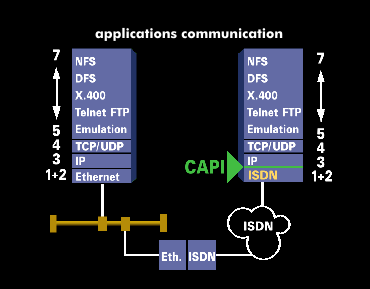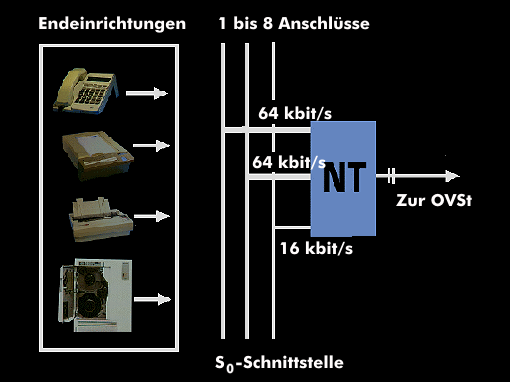integrated services digital network (ISDN)
ISDN is a nationwide service-integrating digital network that evolved from the analog telephone network. ISDN integrates various services in one transmission network. The ISDN network integrates telephone, fax, teletex, video tele phony and data transmission. The user thus has access to a wide range of services in digital form: voice, text, graphics and other data. Consequently, this range of services can also be used by the user in the terminal area.
ISDN was designed as a communications network for voice transmissions, as can be seen from the transmission speed of 64 kbit/s. The digital transmission enables the same treatment of data as for voice transmissions. Digital transmission enables text, graphic and voice data to be handled in the same way. Just as in the analog telephone network, ISDN uses circuit switching, establishing a transparent physical end-to-end connection as required. A physical line is created, as it were, between the communicating end subscribers, which is switched through in the individual ISDN exchanges.
Parallel to existing connections, additional control signals can be transmitted for signaling. Signaling, which operates in store-and-forward mode, has the D channel available between the terminal equipment and the local exchange. Between the ISDN exchanges, signaling takes place via the central signaling channel.
The subscriber interfaces in ISDN
With the use of digital telephone exchanges, the ISDN terminals are provided with a digital subscriber line, the basic access with S0 interface. The subscriber has two basic channels(B channels ) with 64 kbit/s each and a control channel, the so-called D channel with 16 kbit/s, at his disposal.
The digital subscriber line has a combined maximum transmission speed of 144 kbit/s (2B+D). In the two B channels, two different services with a bit rate of 64 kbit/s can be served simultaneously via one line.
In addition to the basic ISDN connection, there is also the primary multiplex connection with the S2M interface. This consists of 30 B-channels and two D-channels (64 kbit/s) and provides a net user data rate of 30 x 64 kbit/s, corresponding to 1.920 Mbit/s. The useful and control signals are combined in a time frame, the 2 Mbit/s frame. The primary multiplex connection has a total transmission rate of 2.048 Mbit/s. Many European countries use this 2.048 Mbit/s variant, which is also known as the E1 system. In America, the primary multiplex connection consists of 23 B channels and one D channel, which corresponds to a user data rate of 1.544 Mbps.
Europe-wide features of ISDN
In addition to long-distance telephony, text, data or facsimile transmission is also possible via the basic channels. ISDN is installed nationwide in Germany and has national specifications. Since other countries also had their own ISDN specifications, 28 operators and 20 countries in Europe have committed themselves to a uniform ISDN system, Euro-ISDN.
ISDN is characterized by many voice-oriented features. For example, three-party conferencing, call waiting, call brokering, call forwarding, and number transfer or suppression. One of the disadvantages of ISDN from the point of view of data transmission is the limitation of the user data rate to a maximum of 1,920 kbit/s and the synchronous structure of the transmission channels, which does not permit dynamic bandwidth distribution.
ISDN distinguishes between three types of connection: the circuit-switched connection via the B channel with the 1TR6 protocol and DSS1 protocol, and the packet-switched connections via the B channel and the D channel with Digital Subscriber System no. 1 (DSS1).


